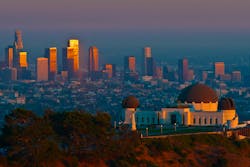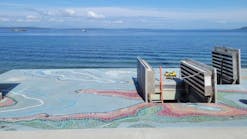Carol Brzozowski is a freelance writer for Water & Wastes Digest. Brzozowski can be reached at [email protected].
The City of Los Angeles Department of Public Works is expected by November 2022 to complete a $13 million Low Flow Diversion (LFD) project as part of a comprehensive effort to improve the water quality in the Los Angeles River and Arroyo Seco.
Both water bodies are negatively impacted by multiple pollutants contained in dry-weather flows with high bacteria levels rivaling that of wastewater at times. Heavy metals and petroleum products also are washed into storm drains and waterways.
New infrastructure to remove dry weather flows from five sub-watersheds to the Los Angeles River and Arroyo Seco was designed by Stantec’s Pasadena office in collaboration with Los Angeles Department of Public Works Bureau of Engineering (LABOE) and Los Angeles Sanitation & Environment (LASAN).
Diverting dry weather flows from the storm drains into existing sanitary sewers and to the city’s Hyperion Water Reclamation Plant (HWRP) for treatment will improve the water bodies’ water quality as well as provide additional treated water to bolster the region’s water security.
We discussed the project with Venu Kolli, Stantec senior principal and project manager; Naushin Kamal, project manager with the City of Los Angeles Bureau of Engineering clean water division, and Seth Carr, environmental engineering associate for the City of Los Angeles.
How do Dry Weather Flows Differ From Wet Weather Flows?
Kolli: Dry weather flow is the flow that typically comes either from the excess waters on the lawns or car washes or other places. They are supposed to go to the sewers, but they end up in the storm drain. They usually pick up a lot of bacteria, pet waste and maybe some trash, oil and metals and end up coming into the storm drain and then will discharge to the receiving bodies and impair the water quality of these channels.
Why is it Important to Address Dry Weather Flows?
Kolli: The City of Los Angeles did an extensive study in 2007 to evaluate the watershed, identify areas that are contributing to these particular pollutants and some of the locations contributing bacteria to the channels.
They needed to implement a project so they could divert the dry weather flows from storm drains rather than discharging into the receiving water bodies back to the sewer so water can be treated at HWRP.
The L.A. River is impaired by multiple pollutants including bacteria, metals, trash, oil, and nutrients. To address these impairments, the Regional Water Quality Control Board has developed total maximum daily loads (TMDLs), which contain compliance schedules for the city to reduce impacts from stormwater discharges.
In order to meet board requirements and keep the water quality of the receiving waters, it is very important to divert these dry weather flows for further treatment at HWRP.
Kamal: It doesn't rain very often in Southern California. Dry weather flows are the biggest contaminant for our natural water bodies in southern California. The project will take that stormwater that originally goes into these water bodies and divert it into the sanitary sewer at our Hyperion treatment plant. That water will be recycled and reused. The zero waste is very beneficial.
There are five different areas based off of historical data from L.A. Sanitation that are identified with the highest level of urban runoff contaminants and bacteria. Those are the locations where we are building the local diversion projects.
RELATED: Critical Repairs in LA: Bypass Solutions
What is the Impact of Dry Weather Flows on Sanitary Sewers?
Kalli: One of the biggest issues is capturing each and every drop of water in Southern California or even in California so water can be used for beneficial uses. The mayor had a mandate to recycle all the wastewater at HWRP by 2035 and use it for indirect potable reuse by groundwater recharge up in San Fernando Valley.
With that in mind, this project protects the water quality of the receiving bodies and also produces more recycled water at HWRP.
The challenge is how to divert these dry weather flows from existing storm drains to sewers. Based on the flow monitoring study, we designed a berm about 9 inches in the storm drains to divert only dry weather flows that back up in front of the berm. Excess flows will flow over the berm and continue to flow to discharge to the receiving water.
The trash in the trash manhole will be cleaned periodically using a vacuum truck. All these minute details were considered in the design to minimize impacts to sanitary sewer and maintain the facilities so they operate efficiently.
The LFDs from this project could divert about 1 million gallons per day from storm drains, while providing no negative impact on wet weather flows from storms. These flows will be treated and can be used for irrigation and other beneficial uses.
Could You Address the Water Scarcity Element & How This Could Provide an Alternate Water Source Given the Drought.
Carr: Currently at the Hyperion treatment plant, the water there is being recycled for seawater intrusion barrier and non-potable water for some industrial sites. There is recycled water piping around Hyperion, like at a Chevron refinery and other refineries. Currently, it's not being recycled 100%. The city has a plan to recycle 100% at Hyperion. They're still discharging to the ocean.
What New Technology Is Being Implemented in Design, Construction and Operation?
Kolli: We designed the LFD systems to have a trash manhole, pump well, valve vault, metering vault and then connect to a sanitary sewer. The dry weather flow first enters the trash manhole, and will be screened so all the trash and sediment settles at the bottom. The water then goes to pump well. The water will be pumped to the sanitary sewer. The flow will be monitored using a flow meter installed in the meter vault before discharging to sanitary sewer. The trash well also has a slide gate so it can be closed to stop diverting dry weather flow to the pump well.
There will be two or three pumps depending on the flows. One is a lead pump and the other one is a standby pump if one of the pumps fail or is taken out for maintenance. Both pumps will operate based on level sensors in the pump well. Once the flow starts increasing in the well, the pump starts pumping and as the flow rises and reaches high level, the system sends a signal to shut off the slide gate in the trash well so dry weather flow will continue to flow in the storm drain.
The level sensors are linked to a SCADA system to send signals to pump, when to start and stop, and also send a signal to shut off the pump station and close the slide gate if needed. The LFD system also has a flow meter installed to monitor the amount of flow going into the sanitary sewer so that L.A. Sanitary Sewer operations will have a record of amount of flow discharging to the sewer.
As the design, engineer and design manager, we worked closely with LASAN and LABOE and other stakeholders to locate these facilities in areas that will have minimum impact to the public and community. LFD facilities are all located below ground on a busy street. Traffic control is important, so we coordinated with the Los Angeles Department of Transportation to get all the approvals for diverting traffic during construction.
Low-flow diversion structures are both the most cost-effective and impactful solutions for improving water quality. This project will help improve water quality in the L.A. River and Arroyo Seco and for millions of Angelenos. This project will make beaches and waters safer and will assist the city in complying with the TMDL requirements as set by the U.S. EPA and U.S. Clean Water Act regulations.
Kamal: Along with the system for local diversion, there are a lot of components working seamlessly together to maximize the best use and have the right data. We can always better ourselves over time with the more information we gather.”
RELATED: What is an Ultrasonic Flowmeter?
Do You Have Any Advice for Other Municipalities Facing Similar Situations?
Kolli: Location of these facilities under a busy street is one of the key challenges to be considered by other agencies who would like to design and construct these facilities. It is very important to find the right location during the planning stage.
A challenge is having to build these facilities in a highly-dense urban area with businesses and residences. Another challenge is identifying all utilities and implementing a traffic control plan to minimize disturbance to day-to-day activities for the local community and maneuvering of shoring and other construction equipment.
Carr: It’s been challenging with the meeting all the permit conditions. We’re under a strict regulatory timeline on this. Interacting with other agencies like L.A. County, we have to get a permit from them to work in their storm drains and they have limitations. Also working in the wet weather is going to be challenging.
Kamal: One of the better things we did on this project was a lot of outreach when we were in the pre-design phase. We worked with all of our constituents in the area, having public meetings (most of them virtual due to the pandemic), doing flyers – we kept the community and the council offices aware of what was going on with the type of work and the impact.
As a project manager, I think communication is key to make sure everyone understands the benefits and the impacts. There are five different sites where we had to coordinate with other construction projects in the area. We had to work with the Los Angeles D.O.T. and Los Angeles County’s building safety officials. There are always challenges, but it's really exciting to know that we've had a beneficial impact for the community and for the environment at the end of the project.


